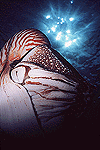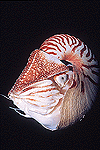PHOTO TIPS FOR PALAU DIVING
PALAU'S CHAMBERED NAUTILUS
Text and Photos by Kevin Davidson
 Sought after for the beautiful shell with it's radial lines and handsome appearance, the chambered nautilus is only found in the Pacific waters in a fifteen degree band near the equator. A member of the chepheapods, it is considered to be in the mollusk family. The nautilus hasn't changed in all of it's 400 million years of existence. In the beginning when it was a heavy shelled bottom dweller, it lifted off the bottom and swam with the power of a water jet. This along with the many small chambers within it's shell, allowed it to defy gravity, thus making itself lighter and allowing the small water jet near their tentacles to work more efficiently. The masters of buoyancy, every divers dream.
Sought after for the beautiful shell with it's radial lines and handsome appearance, the chambered nautilus is only found in the Pacific waters in a fifteen degree band near the equator. A member of the chepheapods, it is considered to be in the mollusk family. The nautilus hasn't changed in all of it's 400 million years of existence. In the beginning when it was a heavy shelled bottom dweller, it lifted off the bottom and swam with the power of a water jet. This along with the many small chambers within it's shell, allowed it to defy gravity, thus making itself lighter and allowing the small water jet near their tentacles to work more efficiently. The masters of buoyancy, every divers dream.
The nautilus lives at depths anywhere in the range of 500 to 1000 feet deep. If you see one while diving your down to deep! However, at night nautilus come up to depths as shallow as 100 to 200 feet to feed on crustacean types of marine life that are also out looking for food. So the only way to observe them is to set a basket style trap in these deep waters and pull them up. Nautilus enjoy near freezing water temperatures but are quite capable of surviving up to 48 hours in warmer waters. The trap, usually a frame wrapped with a close weave mesh or plastic with a 12" hole, is baited with some sort of fish. 
Myself, I use a frozen chicken...yes a chicken! I can't tell you why it works, but perhaps because the nautilus are scavengers and feed off the dead sea life that settles to the bottom, they probably have a keen sense of smell. The chicken fat is just to much to resist. The trap is left overnight to give them time to wander into the opening.
Once inside, they feed or just bounce around. They are unable to quickly find their way back out. The next day the trap is pulled up. Since nautilus are able to take in and release gas, their chambers adjust to the changing depth and they are not injured. In the shallower depths they can be observed, photographed and then released to slowly trundle their way back down to their happy home in the cold and dark deep.
In their natural environment hundreds of feet bellow the ocean, nautilus spend their time roaming the bottom, propelling themselves with a flexible tube. It looks much like when you stick out your tongue and roll it into a tube. This tube can be directed in any angle to steer themselves out of corners and cracks in the reef.
 Above it's tube like jet, is a beaked mouth. Very much like an octopus, and also used to crack open shells. Surrounding all of this are many tentacles which can be extended out or tuck in close to the body. These tentacles are also very sticky enabling the nautilus to pull food close to its mouth making it easier to use that sharp beak to drill into or crack shells and small crabs. The entire living body is located in the first several inches of the shell opening. For protection, the very tough flexible covering can be drawn in, covering the entire soft body including the eyes and tentacles.
Above it's tube like jet, is a beaked mouth. Very much like an octopus, and also used to crack open shells. Surrounding all of this are many tentacles which can be extended out or tuck in close to the body. These tentacles are also very sticky enabling the nautilus to pull food close to its mouth making it easier to use that sharp beak to drill into or crack shells and small crabs. The entire living body is located in the first several inches of the shell opening. For protection, the very tough flexible covering can be drawn in, covering the entire soft body including the eyes and tentacles.
There are several different types of nautilus with only slight variations in the shell appearance. Pompilius being one of the most common type, scrobiculaus is one of the rarest. It has been discovered that on the island of Palau there is an indigenous species given the name Belauensis. The first part of the name Belau being the traditional pronunciation of what is also known as Palau. Macrothalmus, another type has been found in Australia and New Caledonia.
Underwater Digital Photography Online Courses
Web Site Design | Photography | Destination Info | About Us | News & Events | Site Map | Search | Home | Copyright
 Sought after for the beautiful shell with it's radial lines and handsome appearance, the chambered nautilus is only found in the Pacific waters in a fifteen degree band near the equator. A member of the chepheapods, it is considered to be in the mollusk family. The nautilus hasn't changed in all of it's 400 million years of existence. In the beginning when it was a heavy shelled bottom dweller, it lifted off the bottom and swam with the power of a water jet. This along with the many small chambers within it's shell, allowed it to defy gravity, thus making itself lighter and allowing the small water jet near their tentacles to work more efficiently. The masters of buoyancy, every divers dream.
Sought after for the beautiful shell with it's radial lines and handsome appearance, the chambered nautilus is only found in the Pacific waters in a fifteen degree band near the equator. A member of the chepheapods, it is considered to be in the mollusk family. The nautilus hasn't changed in all of it's 400 million years of existence. In the beginning when it was a heavy shelled bottom dweller, it lifted off the bottom and swam with the power of a water jet. This along with the many small chambers within it's shell, allowed it to defy gravity, thus making itself lighter and allowing the small water jet near their tentacles to work more efficiently. The masters of buoyancy, every divers dream.
